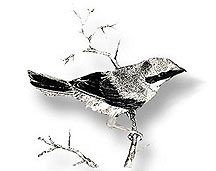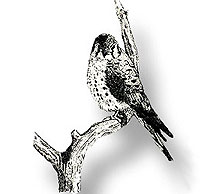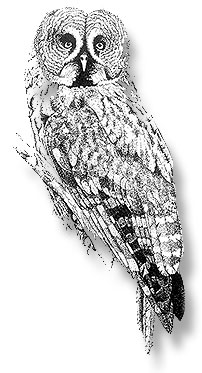


Bird's Eye View: A Practical Compendium for Bird Lovers
By David M. Bird


- .Table of Contents. - .Introduction. -. Tools of the Trade. - Giving Birds a Bath. -

-Are pigeons and house sparrows merely to be despised?
-Do chickadees grow new brains each year?
-Why do vultures defecate down their legs and vomit?
-What does it take to set up an ideal bird feeding station?
-How do birds keep warm in winter?
-What do you do when your child brings home a baby bird?
Of interest to North American bird-lovers everywhere, these are just a sprinkling of the questions to be tackled in this delectable collection of the best of the ornithological essays written by Dr. David M. Bird over the last fifteen years. Not only is Birds-Eye View ideal for those wishing to learn more about the lives of the birds with which we share the planet, it is also an invaluable reference for that growing army of enthusiasts eager to enjoy their company by offering them housing, food and water. Employing plenty of humour, wit and personal family experiences, Dr. Bird's engaging writing style makes Birds-Eye View a delightful, easy-to-read book for anyone with even a passing interest in birds.

Introduction
I am fortunate to be able to have two bird books published in one year. Earlier, I wrote and compiled a book called The Bird Almanac: The Ultimate Guide to Essential Facts and Figures on the World’s Birds. How is this book different from the Almanac?
The Almanac is a compilation of lists and tables of interesting facts on birds and the people dedicated to them. But it does not explain in detail how to set up a bird-feeding program or build and install nest-boxes or discuss how birds keep warm in the winter or how they find their way during migration. Nor does it describe the personalities of the various types of birds.
There is a ton of intriguing information buried in scientific journals that the public never gets to read that I wanted to bring to the attention of people in a way that is enjoyable. The Almanac is strictly a resource book, whereas I would like to believe that Bird’s Eye View is not only informative, but also a good bedtime read—light, interesting and humorous.
Finally, I wanted to write a book that looks at both sides of birds. While some species like the northern cardinal are welcomed at virtually anyone’s feeders because the pair appears to be so lovey-dovey, few people know that they cheat on one another in the breeding season.
The sad aspect of the amazing boom in bird appreciation is that no less than 11 percent of the world’s 9,000 bird species are at risk of global extinction! Hopefully, this book will inform people about the beauty and value of birds and help to convince those in power that the world will a much poorer place without them.
Tools of the Trade

Experienced birders will always tell you that the most important tool for birdwatching is your ears. But trying to observe birds without the aid of a good pair of binoculars is akin to skiing on a pair of rotting barrel staves or surfing the Web on an old 386 computer.Choosing a pair of binoculars to suit your birding needs can be tricky, so here is some terminology that will come in handy.
The power of a pair of binoculars refers to the amount of magnification expressed in first part of the numerical formula engraved on them. The brightness or amount of light admitted by the binoculars is a function of the power and diameter of this latter lens.
High-quality optics are generally made from barium crown glass and low quality from less expensive boro-silicate glass. If you want good binoculars (and you do), all optical surfaces should be coated with a transparent chemical like magnesium fluoride to reduce glare.
The most commonly used binoculars today are center-focusing ones where both barrels of the binocular are adjusted simultaneously by a focusing wheel in the form of a round knob. A desirable feature of the latest breeds is the ability to close-focus on objects that appear within three meters.
As a detective trying to identify the mystery bird, your binoculars serve as your proverbial magnifying glass. But you still need a list of the usual suspects. That's why a good field guide is an absolute must.
Many countries or regions in the world do have a field guide that pertains to them and in many cases, birders may be faced with little choice. However, in North America there are at least half a dozen decent field guides to choose from. And much like binoculars, the choice is dictated by several factors: price, physical size, geographical region covered, and of course, accurate portrayals of the birds, be they photos or paintings. For the most part, the pictures of the birds in the major bird guides available in better bookstores and nature stores serve the reader well.
First, if you expect to bird all over North America, then buy one guide that covers it all. The downsides are, at least in some cases, a heavier book that might not fit into the back pocket of your jeans, as well as a heckuva lot more birds to confuse you. Personally I like having the range maps right beside the bird in question. Arrows pointing out the features to look for are a nice touch. I especially appreciate a guide that makes it very easy to flip the page containing the bird or group of birds under suspicion. Other than that, the provision of enough information to accurately identify the bird is essential.
And that's it--a pair of decent binoculars and a good field guide and you're a well-equipped birder!
Giving Birds a Bath
Some simple inexpensive baths include an inverted metal garbage can lid weighted down on an upraised tile drainage pipe, a chiselled-out stump or log, a ceramic saucer on a tree stump, or even a naturally formed river rock. Commercially available are hanging ceramic dishes, plastic bowls at ground level, concrete or plastic basins on pedestals, and even wood frames with removable plastic trays. Wood baths are difficult to clean and metal ones should be stainless steel or coated with rust-resistant paint which may flake and require occasional repainting.

Here are the basic principles when setting up your bird bath. Let’s start with size. Baths less than30 centimeters in diameter are too small and those between 30 and 45 centimeters are a little crowded for more than one bird. The ideal diameter is about 60 to 90 centimeters.
To avoid slippery footing, the floor should be rough or textured. Concrete, sand, stones or pebbles are preferred over metal or plastic. Roughening the latter surfaces by sanding with coarse sandpaper or sticking on the textured footing commonly found in bathtubs should overcome any problems.
Don’t think deep, either. The depth of the water should be no more than 5 to 7 centimeters. A gradual slope is ideal, say about 2.5 centimeters every 20 cm. Providing a lip or some kind of perch in and around the bath facilitates a slow entry and provides a place to dry off.
But the three most important factors to consider when installing a bird bath are location, location, and location. Remember the famous bathroom shower scene in the movie, Psycho, where the victim did not hear or see the approach of the killer? Never mind the surprise of an ambush, a thoroughly soaked bird will also not easily escape ground and with about five meters of open terrain between it and any vegetation where cats and hawks can hide. Having a high perch just a few meters away where a bird can dry off without worrying about ground predators is helpful.
It is also important to consider the practicability of refilling and occasionally scrubbing the bath with a stiff brush (yes, birds do poop in their bath!). Of course, you’ll want to locate your bath where you can enjoy watching the birds, too.
Since many birds splash about in their baths, you might want to prevent the area from becoming a soggy mudhole by placing the bath on a well drained sand or gravel base, or even on a patch of patio stones.
To attract birds to your new bath, incorporate the sound of moving water by installing a commercially bought spray-maker. Even water dripping from a hose or from a leaky bucket suspended over the bath will do nicely.
For those of you living in colder climates for the winter months, be a little cautious with heated birdbaths. Under normal winter conditions, they’re not a problem, but when things become extraordinarily chilly, you might want to restrict access to the bath by covering it or turning the heater off. I have had a number of people complain to me that they have experienced birds incapacitating themselves and even freezing to death after bathing in heated water. Yes, I an aware that there are unfrozen bodies of water, such as suburban streams, available to birds in winter, but it may be that the water is very cold and inhibits their desire to bathe, whereas a heated bath does bot. Better safe than sorry.
Bathing in the dirt sounds like an oxymoron, but not to the birds. Lots of backyard birds like quail and sparrows like a good dust bath. The function is not well understood, but it is probably to control ectoparasites like lice and mites. Making a dusting area is easy. Over a square meter or so, excavate the soil to a depth of about 15 centimeters and line it with rocks or bricks for aesthetics. The best dust mix is a third each of sand sifted and loam. Watching birds taking either a water or a dust bath is even more pleasurable than taking in their feeding behavior. There is something refreshing about it.
Table of Contents
Contents of Bird's Eye View
Preface
1. Bird-watching
Am I Really a Bird?
Definition of the Birder
Bird-watching means big bucks
Have Binos, Will Travel
Magic Moments with the Birds
Tools of the Trade
2. Birds in the Back Yard
Should We Feed the Birds?
How to Operate a Fast-Food Outlet for Birds
No Fat-Free Diets for the Birdies
Giving the Birds a Bath
Little Birds with a Big Sweet Tooth
The Squirrel Wars
Dealing with Birds of Prey in the Backyard
Weird Nesting Sites
A Housing Crunch for Birds
Condos for Purple Martins
What to Do with Orphaned Birds
Keeping Cats and Birds Safe
Pesticides and Birds
Birds, Buildings, Jets and People-A Striking Problem
3. Basic Bird Biology
Bird-Brains
Tool-using Birds
Can Birds Smell?
Do Birds Have Poor Taste?
Pass the Salt, Please!
How Birds Beat the Winter Chill
Why do Birds Change Their Feathers?
Splish, Splash, I Was Taking a Bath!
Anting: Getting Rid of the Creepy-crawlies
The Poop on Bird Poop
Singing Their Little Hearts Out!
Are You Mocking Me?
Why are Birds so Brightly Colored?
My, What a Long Tail You Have!
Gay Birds?
Is Incest Best for Birds?
Feathering One's Nest
A Whole Lotta Cheatin' Going On!
Super-Moms Among Birds
Do Birds Really Mate for Life?
Time to Leave the Nest, My Child!
He's Weird Looking, but He's One of Us!
How Migrating Birds Find Their Way Without Stopping to Ask for Directions
Old-Person Tales for Bird-Lovers
Who's the Biggest and Who's the Fastest?
4. Birds We've Come to Love and Hate
House Sparrows: The Great Pretenders
Pigeons: The Ultimate Love-Hate Relationship
Gulls Can Really Gall You!
The European Starling: A Model of Persistence
The Common Crow: The Craftiest of Critters
Cowbirds are no Homemakers!
The Canada Goose: An Unwelcome Canadian Ambassador?
Those "Viley" Vultures!
The Blue Jay: Colorful, Cunning and Caustic
Those Chisellin' Woodpeckers
Grackles Are Would-be Hawks
The House Wren: Cute, but Nasty!
City-loving Peregrines
Why Do Hummingbirds Hum?
The Bluebird: True Harbinger of Spring
Am I a Purple Finch or One of Those Hollywood Types?
The Red, Red Robin Goes Bob-Bob-Bobbin' Along
Those Innocuous Nuthatches
Those Wandering Waxwings
A Blur of Redpolls
Loons: The Other Side of the Coin
Meet My Favorite Songbird, the Dipper
Index
Preface
1. Bird-watching
Am I Really a Bird?
Definition of the Birder
Bird-watching means big bucks
Have Binos, Will Travel
Magic Moments with the Birds
Tools of the Trade
2. Birds in the Back Yard
Should We Feed the Birds?
How to Operate a Fast-Food Outlet for Birds
No Fat-Free Diets for the Birdies
Giving the Birds a Bath
Little Birds with a Big Sweet Tooth
The Squirrel Wars
Dealing with Birds of Prey in the Backyard
Weird Nesting Sites
A Housing Crunch for Birds
Condos for Purple Martins
What to Do with Orphaned Birds
Keeping Cats and Birds Safe
Pesticides and Birds
Birds, Buildings, Jets and People-A Striking Problem
3. Basic Bird Biology
Bird-Brains
Tool-using Birds
Can Birds Smell?
Do Birds Have Poor Taste?
Pass the Salt, Please!
How Birds Beat the Winter Chill
Why do Birds Change Their Feathers?
Splish, Splash, I Was Taking a Bath!
Anting: Getting Rid of the Creepy-crawlies
The Poop on Bird Poop
Singing Their Little Hearts Out!
Are You Mocking Me?
Why are Birds so Brightly Colored?
My, What a Long Tail You Have!
Gay Birds?
Is Incest Best for Birds?
Feathering One's Nest
A Whole Lotta Cheatin' Going On!
Super-Moms Among Birds
Do Birds Really Mate for Life?
Time to Leave the Nest, My Child!
He's Weird Looking, but He's One of Us!
How Migrating Birds Find Their Way Without Stopping to Ask for Directions
Old-Person Tales for Bird-Lovers
Who's the Biggest and Who's the Fastest?
4. Birds We've Come to Love and Hate
House Sparrows: The Great Pretenders
Pigeons: The Ultimate Love-Hate Relationship
Gulls Can Really Gall You!
The European Starling: A Model of Persistence
The Common Crow: The Craftiest of Critters
Cowbirds are no Homemakers!
The Canada Goose: An Unwelcome Canadian Ambassador?
Those "Viley" Vultures!
The Blue Jay: Colorful, Cunning and Caustic
Those Chisellin' Woodpeckers
Grackles Are Would-be Hawks
The House Wren: Cute, but Nasty!
City-loving Peregrines
Why Do Hummingbirds Hum?
The Bluebird: True Harbinger of Spring
Am I a Purple Finch or One of Those Hollywood Types?
The Red, Red Robin Goes Bob-Bob-Bobbin' Along
Those Innocuous Nuthatches
Those Wandering Waxwings
A Blur of Redpolls
Loons: The Other Side of the Coin
Meet My Favorite Songbird, the Dipper
Index
Book Reviews
Eirik A.T. Blom
"By the time you have stopped chuckling and reading passages aloud to your companion, you have finished a short course in beginning ornithology. You will see birds in a new way and recognize behaviors that you didn't even know existed. I have been reading ornithological literature for 25 years but I read this book cover to cover and felt like I learned something on every page."
McGill News Alumni Quarterly
"A must have for bird-freaks."
Montreal Gazette - Saturday, February 19, 2000
Margaret Gunning
"Bird set out to write a book which would both inform and entertain - a good bedtime read, light, interesting and humorous. He has more than succeeded. Though there is much here to delight the serious birder, his observations and anecdotes will win over many a more casual observer.
So if you want to learn how to operate a fast-food outlet for the birds or build a condo for purple martins, this is the book for you. But it's also for anyone who has ever looked up and noticed the fluttering life around them and marveled at the diversity and cleverness of some of God's loveliest creatures."
About the Author

Illustrated: Yes
Cover: Quality Paperback
Size: 6x9
No. of Pages: 274
Price: $17.95 U.S. 22.95 CDN
Restless Energy A Biography of William Rowan 1891-1957, by Marianne G. Ainley
| home | titles | ordering | sitemap | our press | signal editions poetry | esplanade fiction | montreal writers | events |
| news | montreal restaurant guides | montreal city guides | chapbook | jewish studies | canadian studies |
| contact us |
www.vehiculepress.com
© Véhicule Press, All Rights Reserved